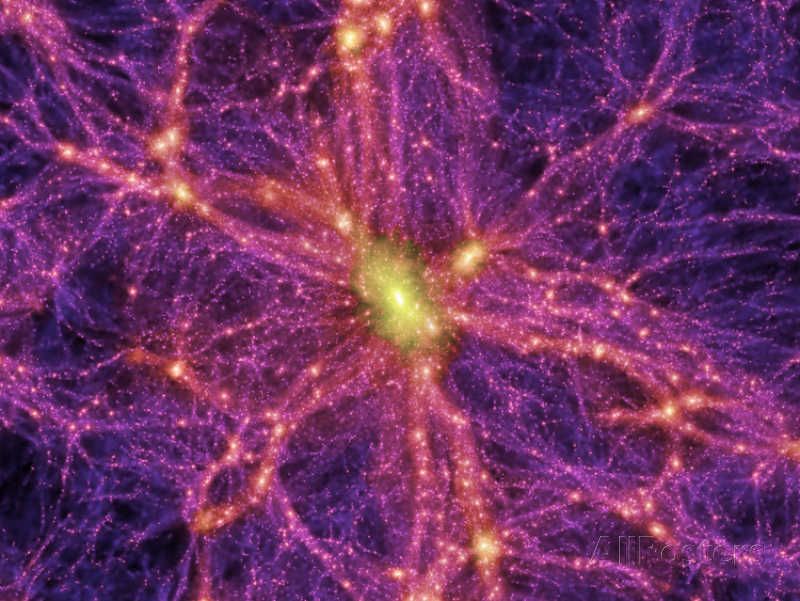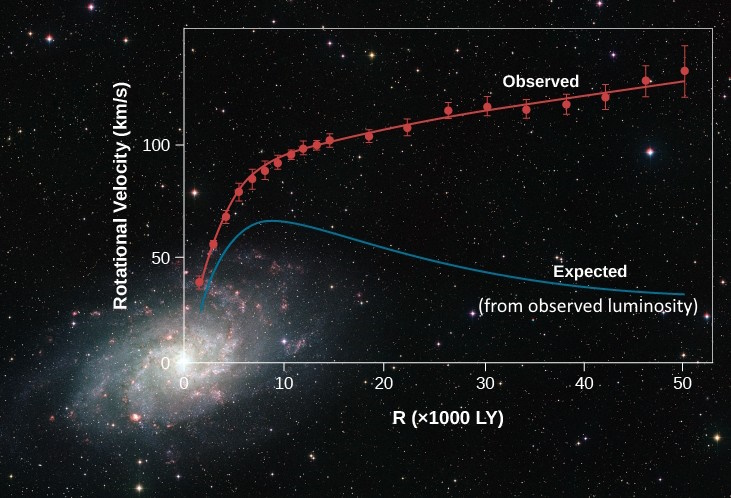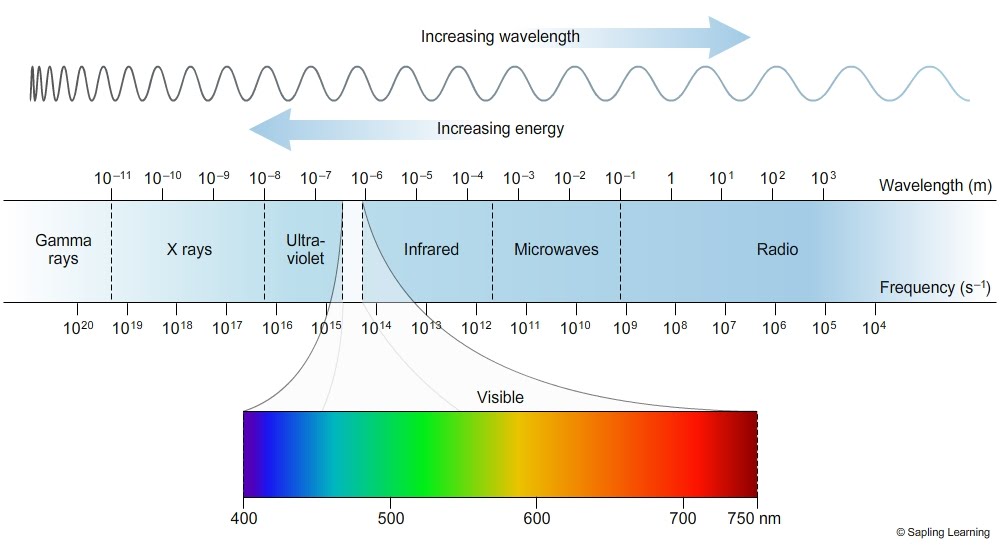
Here we are, people–it’s finally time to talk about dark matter!
I’ve teased this subject in my last few posts. We’ve discussed how the idea originated–with observations of the rotation of galaxies. We’ve touched on the question of whether dark matter could explain supermassive black holes.
What we have yet to do is take a proper deep dive into what the heck this stuff actually is. But there’s an even more important question…
How do we know it’s actually real?
First, let’s take a look at what we think we know about dark matter.
Astronomers first came up with the idea of dark matter when observing galaxies’ rotation–or, more specifically, their rotation curves.

What do I mean by rotation curves, again?
Like planets around a star, everything in a galaxy–stars, solar systems, dust clouds, etc–orbits around the center of the galaxy. And those orbits are why the galaxy as a whole appears to rotate, a bit like a frisbee.
When we observe a galaxy’s rotation, what we’re really observing is the motion of stars around its center. We can graph this motion–specifically, the stars’ velocities–according to the stars’ distances from the center of the galaxy.
That’s how we produce a rotation curve. And we can use this rotation curve to estimate a galaxy’s mass; that is, how much matter it contains.
But here’s where things start getting weird.
We should also be able to estimate how much matter a galaxy contains based on its luminosity: the total light, across the whole electromagnetic spectrum, that all the stuff inside it emits.
That’s this spectrum, by the way:

All the stars in any galaxy are quite well represented in visible and near-infrared wavelengths. Observations in the far-infrared account for the interstellar dust clouds. And X-rays reveal black holes and neutron stars.
We know how much mass these types of objects generally have. Add it all together, and we should have the galaxy’s mass, right?
Wrong. It’s about ten times smaller than the mass that the rotation curve reveals.
That’s, um, kind of a ridiculous discrepancy. Well outside of acceptable error margins.
The rotation curve is definitely reliable, because according to Einstein’s theory of general relativity, gravitation–and, therefore, orbital motion–is a direct effect of mass. A galaxy’s luminosity is much more likely to be an approximation.
It would seem that there’s some kind of matter we can’t see.
Yup. Matter we can’t see. Dubbed, by astronomers, as “dark matter.”

Dark matter began as an idea astronomers came up with to explain this discrepancy. We didn’t know then what it actually was, and we still don’t know now.
We know that it’s dark–that is, we can’t see it. And we know that there’s a crap ton of it. Literally about ten times more of it than visible matter.
We’ve seen more evidence of it in clusters of galaxies such as the Coma cluster, too…

In the Coma cluster–like many other galaxy clusters–the intergalactic space is filled with hot, low-density gas. The gas is so hot that it’s observable in X-ray wavelengths.
But if a gas is hot, that means its atoms are moving very rapidly–and this gas is so hot that, according to Newton’s laws, its atoms should have escaped the cluster altogether. That is, unless an unseen mass of dark matter holds the gas captive.
Observations of galaxies’ rotation curves indicate there must be ten times more dark matter than visible matter, and together with observations of galaxy clusters, astronomers estimate that about 90% of all the matter in the universe must be dark matter.

Wait a second, what’s that new term on this pie chart? What the heck is dark energy?
Don’t worry, we’ll get to that–when we move on to our discussion of cosmology!
But in the meantime…what the heck could dark matter be?
It can’t be notoriously elusive objects like black holes or neutron stars. We’d definitely notice the X-rays from that many of them. It also can’t be small and faint objects such as white dwarfs, red dwarfs, or brown dwarfs–again, there just aren’t enough to account for the extra mass.
Dark matter must be made up of something else, something that’s not “normal” matter–known in astronomical circles as baryonic matter. And it doesn’t seem to interact with baryonic matter, either. Or even with itself.
The wacky world of quantum mechanics gives us a couple of possible culprits, such as axions and “WIMPS” (Weakly Interacting Massive Particles). But so far, efforts to link dark matter with known particles have been unsuccessful.
And all that makes astronomers wonder…is dark matter actually real? Or could some quirk of gravity we don’t understand just make it seem to be there?
Good thing there’s another way to detect dark matter, one that doesn’t rely on Newton’s laws…

This is an image of a galaxy cluster.
Okay, I’m just going to stop us right there. What the heck is going on with that weird, wiggly arc of a galaxy?
I’ll give you a hint: that is not what the galaxy really looks like. It’s a normal disk galaxy.
It’s being gravitationally lensed.
Wait…say what?
Let’s take a step back for a moment. Remember how I said up above that, according to Einstein’s theories, gravitation is a direct result of mass?
More specifically, the presence of mass curves the fabric of space-time, like this:

Here, you see the Earth’s mass curving the space-time around it. Like rolling down a hill, the moon would sort of “fall” into this little dimple in space-time, and remain in orbit around the Earth.
But it’s not just matter that reacts to curvature in space-time. Light also does.

In a vacuum, light always travels in a straight line–unless it stumbles across a gravitational “well,” if you will. It’ll be deflected around the object creating the well–say, the sun–like a golf ball rolling over a dip in a putting green.
The result is that, from Earth, the light appears in a different spot in the sky from where it actually is. (Observations made during total solar eclipses helped document this phenomenon.)
And that brings me back to gravitational lensing.

What’s happening here is that the light from a much more distant galaxy is getting deflected around the mass of a nearer galaxy cluster.
The distant galaxy then appears distorted. It looks stretched out, and it can even get mirrored–appearing in multiple places around the foreground cluster.
This effect is always an indication of strong gravitational forces within the foreground cluster. The amount of distortion depends on the strength of the foreground cluster’s gravity.
Essentially, the dimple in space-time acts like a curved lens; hence the name “gravitational lensing.”
And there’s way too much gravitational lensing for the observable mass in these clusters. That tells us that dark matter probably is real.
Gravitational lensing has even helped prove that dark matter doesn’t interact with itself, or with baryonic matter…

Meet galaxy cluster 1E0657-56: a pair of two galaxy clusters that passed through one another about 100 million years ago.
This is a false-color image–that is, an image showing observations in wavelengths other than visible light. The non-visible wavelengths are color-coded, but they wouldn’t really appear in these colors to the human eye.
Here, you can see two distinct groupings of yellow-ish galaxies, observed in visible light. These are the two separate clusters. Hot gas–made up of baryonic matter–is shown in pink, observed in X-ray wavelengths.
Notice that the gas doesn’t line up with where the actual galaxies are. When the clusters passed through each other, the gas collided and was swept clear of the clusters.
But, thanks to gravitational lensing, we can detect where there are clumps of dark matter present in these clusters. It’s shown as a purple haze. And you’ll notice that it’s very much still surrounding the galaxies themselves.
Apparently, the dark matter in these clusters didn’t collide. It wasn’t able to interact with itself or with baryonic matter present. It remained gravitationally bound to the individual clusters themselves.
Now, the two clusters are moving apart from one another in opposite directions–gas-free, but carrying their dark matter with them.

It would seem that dark matter is real, existing as some mysterious particle or particles, separate from baryonic matter and yet to be discovered.
But the question remains–what is it?
We don’t know yet. But we will come back to this question–and that of dark energy–in our discussion of cosmology.
Next up, though, we’ll explore how galaxies evolve!
There seems to be this struggle between dark matter and modified gravity – what’s your take on that?
I personally love the thought that we can only detect about 5% of the content of the universe. It makes it more mysterious.
LikeLiked by 1 person
I’m going to have to say that I don’t know enough either way. All I know at this point is that gravitational lensing is evidence in favor of dark matter independent of Newton’s laws. Beyond that, I’m not up on the new research.
LikeLiked by 1 person
I don’t know either – I was keen to know your thoughts but it does seem that dark matter exists in some way
LikeLiked by 1 person
I LOVE the idea of dark matter. Sends shivers down my spine! (And there does seem to be strong evidence in its favor.) Definitely is always good to exercise healthy skepticism, though. Questioning our assumptions is foundational to good science.
LikeLiked by 1 person
I agree totally and that mindset is essential for questioning realty in general. I love the idea that the universe we can currently see and detect is just a tiny part of what there is… it blows the mind
LikeLiked by 1 person
Definitely!
LikeLiked by 1 person